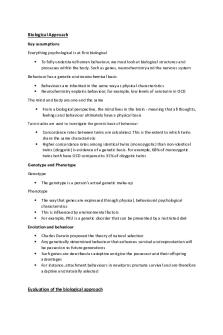Biological approach PDF

| Title | Biological approach |
|---|---|
| Author | Harvey West |
| Course | Biological Psychology |
| Institution | University of Bristol |
| Pages | 2 |
| File Size | 60.7 KB |
| File Type | |
| Total Downloads | 74 |
| Total Views | 179 |
Summary
Notes...
Description
Biological Approach Key assumptions Everything psychological is at first biological
To fully understand human behaviour, we must look at biological structures and processes within the body. Such as genes, neurochemistry and the nervous system
Behaviour has a genetic and neurochemical basis
Behaviours are inherited in the same way as physical characteristics Neurochemistry explains behaviour, for example, low levels of serotonin in OCD
The mind and body are one and the same
From a biological perspective, the mind lives in the brain - meaning that all thoughts, feelings and behaviour ultimately have a physical basis
Twin studies are used to investigate the genetic basis of behaviour
Concordance rates between twins are calculated. This is the extent to which twins share the same characteristic Higher concordance rates among identical twins (monozygotic) than non-identical twins (dizygotic) is evidence of a genetic basis. For example, 68% of monozygotic twins both have OCD compared to 31% of dizygotic twins
Genotype and Phenotype Genotype
The genotype is a person’s actual genetic make-up
Phenotype
The way that genes are expressed through physical, behavioural psychological characteristics This is influenced by environmental factors For example, PKU is a genetic disorder that can be prevented by a restricted diet
Evolution and behaviour
Charles Darwin proposed the theory of natural selection Any genetically determined behaviour that enhances survival and reproduction will be passed on to future generations Such genes are described as adaptive and give the possessor and their offspring advantages For instance, attachment behaviours in newborns promote survival and are therefore adaptive and naturally selected
Evaluation of the biological approach
1. A strength is its use of scientific methods of investigation In order to investigate the genetic and biological basis of behaviour, a range of highly precise and scientific methods are used These include scanning techniques and drug trials, which makes it possible to accurately measure biological and neural processes in ways that are not biased This means that the approach is based on reliable data 2. A strength is the real-life application An increased understanding of biochemical processes in the brain has led to development of psychoactive drugs Although these drugs are not effective for all patients, they have revolutionised treatment for many This is a strength because it means that sufferers are able to live relatively normal lives 3. A limitation is that causal conclusions about neurotransmitters are difficult to establish It is often assumed that neurotransmitters are the cause of many mental disorders since drug studies show that that a change in neurotransmitter levels reduces symptoms of many disorders However, this is like assuming that the cause of a headache is a lack of paracetamol simply because it is effective in relieving the symptoms This is a limitation because the approach is claiming to have discovered causations where only an association exists 4. Another limitation is that the approach is determinist The approach is determinist in that it sees human behaviour as governed by internal, biological forces in which we have no control However, this is at odds with the legal system which likes to put moral responsibility on the offender Such research may have negative implications for wider society as criminals may be able to excuse their behaviour 5. A final limitation is the difficulty of separating nature and nurture Identical twins, non-identical twins family members all have genetic similarities, so any similarity in behaviour must be genetic from a biological perspective However, the fact that family members are exposed to similar environmental conditions is an important confounding variable This is a problem for the approach because findings could just as easily be interpreted as supporting nurture rather than nature...
Similar Free PDFs

Biological approach
- 2 Pages

Biological Rhythms
- 20 Pages

Biological Treatments
- 5 Pages

Biological Foundations
- 24 Pages

Biological Positivism
- 4 Pages

Biological Model OF Addiction
- 26 Pages

Biological Psyhology TMS essay
- 6 Pages

Biological Anthropology Notes
- 32 Pages

Vision in Biological Psychology
- 11 Pages
Popular Institutions
- Tinajero National High School - Annex
- Politeknik Caltex Riau
- Yokohama City University
- SGT University
- University of Al-Qadisiyah
- Divine Word College of Vigan
- Techniek College Rotterdam
- Universidade de Santiago
- Universiti Teknologi MARA Cawangan Johor Kampus Pasir Gudang
- Poltekkes Kemenkes Yogyakarta
- Baguio City National High School
- Colegio san marcos
- preparatoria uno
- Centro de Bachillerato Tecnológico Industrial y de Servicios No. 107
- Dalian Maritime University
- Quang Trung Secondary School
- Colegio Tecnológico en Informática
- Corporación Regional de Educación Superior
- Grupo CEDVA
- Dar Al Uloom University
- Centro de Estudios Preuniversitarios de la Universidad Nacional de Ingeniería
- 上智大学
- Aakash International School, Nuna Majara
- San Felipe Neri Catholic School
- Kang Chiao International School - New Taipei City
- Misamis Occidental National High School
- Institución Educativa Escuela Normal Juan Ladrilleros
- Kolehiyo ng Pantukan
- Batanes State College
- Instituto Continental
- Sekolah Menengah Kejuruan Kesehatan Kaltara (Tarakan)
- Colegio de La Inmaculada Concepcion - Cebu






